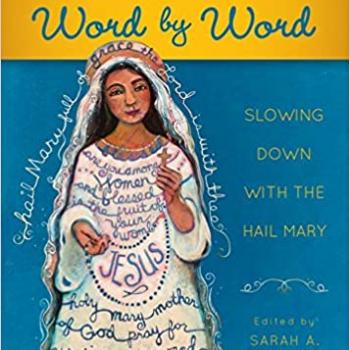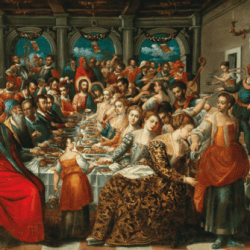South Carolina is basically one big small town, so the odds are high that I have kin or acquaintance at Red Bank Baptist Church. I have nothing ill to say about the place, not even after the congregation’s latest art problem went viral. I do think, however, that there’s something Patheos readers across the channels should be thinking about in the whole “Too Catholic” problem.
It’s Not About the Art
There is nothing to be gained by quibbling over whether the congregation should or should not love its art. Being a Christian church-artist is a harrowing proposition: You are commissioned to paint, sculpt, etch, compose, or perform a work that touches the most important, most sacred part of someone’s inner life, and somehow you’re supposed to do that in a way that stirs and satisfies the hearts of hundreds or thousands of people — people who couldn’t agree what temperature to set the thermostat, forget about questions of taste.
So it’s inevitable that not everyone is going to love the Jesus tableau. Even if it was fresh and inspiring a decade ago, you might reach a point where you’re ready for something different. Not far from Red Bank Baptist is Corpus Christi Catholic Church, where Fr. Ray Carlo has been doing a magnificent job of salvaging art from older (closing) parishes around the country and slowly making the relatively recently-built neo-traditional parish more “Catholic” feeling. I could imagine him being tempted to gently decline a work like Red Bank Baptist’s Jesus statue by perhaps saying that it doesn’t quite mesh with a Catholic aesthetic sensibility. And yet you know we Catholics love us some Jesus statues, and there are plenty of Catholic parishes where Red Bank’s art would fit right in.*
Or perhaps Red Bank Baptist wasn’t just looking for a polite way to take down last decade’s artwork. Perhaps they really do have concerns about seeming “too Catholic.” And that is relevant to those of us who run in ecumenical circles.
What Does it Mean to be Protestant?
I’ve had a foot in the Evangelical world for a lot of years now, and every now and then I hear someone say, “Don’t call me Protestant. Call me Christian. I’m not protesting anything, this is just what I believe.”
These people are genuine. They’ve inherited a way of looking at Scripture and looking at the faith that does indeed descend from true protests against the Catholic Church, but they themselves have no fight with Catholics. They are open to any Christian of good will who can sign on to something like CS Lewis’s concept of “Mere Christianity.” When they find common ground with Catholics, they don’t panic.
Here’s an example: At my son’s baptism was a good friend, Christian but not Catholic, who’d never attended a Catholic Mass. I asked her afterwards if she was bothered by the use of Mary’s title “Mother of God.” She told me, “Well, I noticed it, because I’ve never heard anyone say that before. But then I thought about it, and I realized, well, yes, she is the mother of Jesus, and Jesus is God, so I guess why not?” She didn’t drop everything and run out and buy a rosary. But she was fine with other Christians talking about something that was a plain fact right out of Scripture.
Contented, confident “mere Christians” do exist, and they are increasingly drifting into post-Protestant Christianity.
Protesting Too Much?
I’ve volunteered, studied, prayed, and worshiped with post-Protestant mere-Christians. And then I’ve run into true Protestants.
Here’s an example: I was looking around at teaching jobs and came across a school that was hiring in a field I’d be qualified to teach. I doubted they wanted Catholics, but I wasn’t going to assume. I clicked around and found the statement faith. It was one that a Catholic could sign in good conscience.
It’s actually pretty hard to write a mere-Christian statement of faith that manages to keep the diversity of Evangelicals in the net without accidentally writing something Catholic-compatible. When you get onto a topic like, say, free will and predestination, there’s more argument among various shades of Protestants than there is between Catholicism and the average Evangelical.
In a previous generation this school I was looking at might have published a statement of faith that took a strict position along a single denomination’s theology; but these days there’s too much denominational cross-pollination.
In my personal set of friends are a born-and-raised Pentecostal now worshiping at St. Evangelical the Anglican; a retired Assemblies of God pastor tiptoeing through the TULIP at Downtown Prez; friends who’ve reluctantly left Countryside Baptist in order to hang with the First Things crowd at Craft Brew Suburban Reformed; friends raised at St. John Wesley’s Methodist Or Bust now attending Bursting at the Seams Southern Baptist . . . and no shortage of others who choose their church home based on the preaching, the worship service, the community, or even just the physical location, and don’t necessarily even know or care what the official denominational affiliation of the place might be.
Hiring instructors based on strict denominational purity is a non-starter for any Evangelical school trying to grow its staff rather than shrink it.
So the school had an ingenious solution to the statement of faith problem: In addition to signing off on the school’s mere-Christian theology, you also had to be an active, participating member in a Protestant congregation.
Mere Christians, Unite!
Ironically, if I wanted to meet that requirement all I’d need to do is get back involved someplace like the group of non-denominational Evangelicals I used to worship with twenty years ago. They didn’t mind my being openly Catholic, had no problem with my reading their statement of faith through a Catholic lens, and were perfectly happy for me to sing, pray, and study for a few hours a week in Evangelical world and then skip on over to Mass at St. Statuesque. They were not against Catholics. They were for Christianity.
We are living in a time when we need more of this.
What is a Mere Christian?
I’ve seen some people get all in a huff about the American Bible Society requiring employees to sign a statement of faith. Go read it (scroll down to the bottom of the CT article). There’s nothing in that statement that a Catholic couldn’t happily sign. It’s the historic creed plus an affirmation of our basic beliefs about Christian life in general and marriage in particular. Note even the subtle distinction between the “I believe” affirmations of the creed versus the “I will seek” aspirations of the statements on Christian morals: The ABS doesn’t demand you be perfect, it only asks that these basic Christian beliefs be your goal and your ideal.
There’s an old joke that goes like this:
What’s the difference between a liberal Catholic and a conservative Catholic?
A liberal Catholic is more comfortable with a Mainline Protestant than with an Evangelical.
A conservative Catholic is more comfortable with an Evangelical than with a liberal Catholic.
I take exception to the idea that I’m a “conservative” Catholic. I’m just Catholic. I believe all that stuff in the Catechism, done. And if you believe that stuff in the Catechism, you have more in common with a statue-shy Evangelical than you do with people — no matter what they call themselves — who can’t abide the American Bible Society drawing a line around a few important bits of mere-Christianity.
I suspect Evangelicals are catching on to this. The Facebook uproar over Red Bank Baptist’s persistent-Protesting suggests that there are a lot of people who can see clearly the need for post-Protestant mere-Christianity.

*Some of us, of course, think the tableau will only come into its own once it’s been painted glow-in-the-dark. We like our sacred pop art deeply kitschy, thanks.












